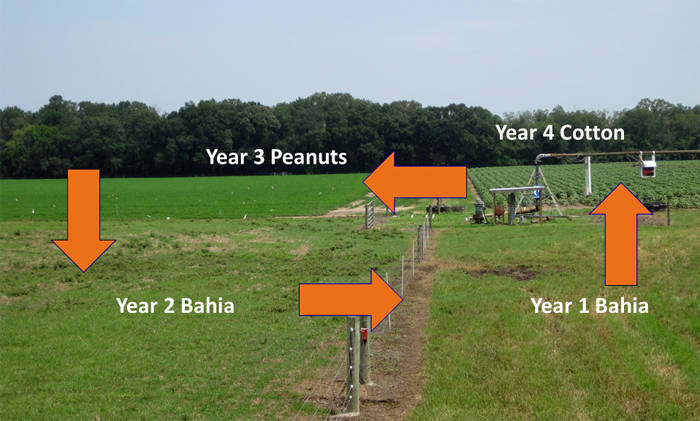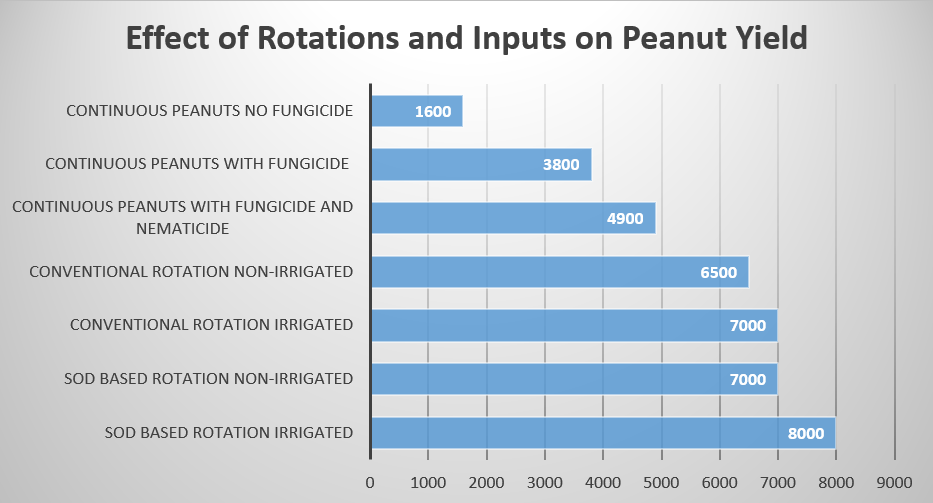
In the Sod-Based Crop Rotation Project at NFREC Marianna, the 160 acre field is divided in quadrants and rotated with 2 years of bahiagrass, followed by a year of peanuts and then a year of cotton. Photo credit: Doug Mayo
Jim Marois and David Wright, UF/IFAS NFREC Agronomy Research
It is not a good idea to produce peanuts on the same land for 3-5 years in a row in the Florida Panhandle. This practice can create a serious long term problem, because pest pressure will build up and reduce peanut yields. All crops, but especially legumes, benefit from rotation. This is a problem that cannot be solved by adding more pesticides. It is also a problem for long term management of your land, because once pests build up they do not go away for a long time. One example is peanut white mold (Sclerotium rolfsii) which has a survival structure (sclerotia) that can live for several years in the soil.
At NFREC-Quincy we have intentionally planted continuous peanuts for 4 years to establish high levels of disease for fungicide research trials. These trials are on the same soil (Dothan sandy loam) as our crop rotation studies, where we grow peanuts every 4 years after a year of cotton and 2 years of Bahia grass (our “sod based rotation”). This is compared in the same field to a conventional rotation of 2 years of cotton and 1 year of peanuts produced, under conservation tillage, with and without irrigation. Over the years, the benefits of rotation and pesticides are obvious in the trials. In 2014, the continuous (4 years) of irrigated peanuts without fungicides yielded 1600 lbs. per acre. With a standard fungicide program it was 3800 lbs. per acre. When a nematicide (Velum from Bayer CropScience) was added to the fungicide program yield increased to 4900 lbs. per acre. However, in the nearby rotation plots, which all received a conventional fungicide program, the irrigated plots had a yield of 8000 lbs. per acre. The non-irrigated sod based rotation had a yield of 7000 lb. per acre, the same as irrigated peanuts in the conventional cotton-cotton-peanut rotation. In the non-irrigated conventional rotation, yield was 6500 lbs. per acre. The take home lesson is that crop rotations work, sod rotations work better, and continuous peanuts can set you up for declining yields. For example, the white mold pathogen previously mentioned, not only survives in the soil for several years, it has a very large host range of over 500 species. Once soil becomes contaminated with pathogens, many of them can be very hard to manage on future crops. The increase in costs of pesticides, reduction in yields, and reduction of soil health all make continuous peanut production more challenging in the long run, regardless of the perceived short term benefits. In a year such as 2015, when crop market forecasts are down, high yields from good crop rotation, as noted above, may be the only way to return a profit.
The take home lesson is that crop rotations work, sod rotations work better, and continuous peanuts can set you up for declining yields. For example, the white mold pathogen previously mentioned, not only survives in the soil for several years, it has a very large host range of over 500 species. Once soil becomes contaminated with pathogens, many of them can be very hard to manage on future crops. The increase in costs of pesticides, reduction in yields, and reduction of soil health all make continuous peanut production more challenging in the long run, regardless of the perceived short term benefits. In a year such as 2015, when crop market forecasts are down, high yields from good crop rotation, as noted above, may be the only way to return a profit.
For more information on this subject:
Sod/Livestock-Based Peanut/Cotton Production System: Why We Recommend It!
- Reducing Water Demand for Agriculture - June 12, 2015
- Crop Rotation May Determine the Profitability of Peanuts in 2015 - January 30, 2015
- Soybean Rust Update - August 22, 2014
